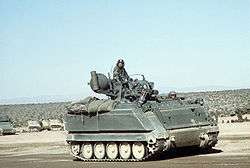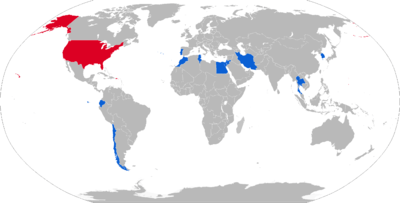M163 VADS
| M163 VADS | |
|---|---|
|
A U.S. Army M163 from the 24th Infantry Division at the National Training Center in November 1988. | |
| Type | Self-propelled anti-aircraft gun |
| Place of origin | United States of America |
| Service history | |
| In service | 1968–present |
| Used by | United States of America, NATO |
| Wars |
Vietnam War Western Sahara War 1982 Lebanon War Invasion of Panama Persian Gulf War |
| Specifications | |
| Weight | 27,542 pounds (12,493 kg) (combat weight) |
| Length | 191.5 inches (4.86 m) |
| Width | 112.4 inches (2.85 m) |
| Height | 115 inches (2.9 m) |
| Crew | 4 (commander, gunner, loader, driver) |
|
| |
| Armor | Rolled 5083/5086 H32 aluminium, 29-45 |
Main armament |
M168 General Dynamics 20 mm Vulcan Gatling autocannon 1,100 rounds |
Secondary armament | None/crew small arms |
| Engine |
General Motors 6V53, 6-cylinder two-stroke diesel 212 hp (158 kW) |
| Suspension | torsion bar, 5 road wheels |
Operational range | 480 km (300 mi) |
| Speed | 64 km/h (40 mph) |
The M163 Vulcan Air Defense System (VADS) is a self-propelled anti-aircraft gun (SPAAG) that was used by the United States Army. The M168 gun is a variant of the General Dynamics 20 mm M61 Vulcan rotary cannon, the standard cannon in most U.S. combat aircraft since the 1960s, mounted on either an armored vehicle or a trailer.
Technical description
The weapon is mounted on a modified M113 vehicle (the M741 carrier). The system was designed to complement the M48 Chaparral missile system. The M163 uses a small, range-only radar, the AN/VPS-2, and an M61 optical lead-calculating sight. The system is suitable for night operations with the use of AN/PVS series night vision sights that can be mounted to the right side of the primary sight.
The gun fires at 3,000 rounds per minute in short bursts of 10, 30, 60, or 100 rounds,[1][2] or it can fire in continuous fire mode at a rate of 1,000 rounds per minute. A linkless feed system is used.[3]
Performance
From the beginning, the main drawback of the M163 was its small caliber and lightweight shells, which limited its effective range. Early M50 series ammunition exacerbated the situation, but the M163 was still comparable to the contemporary Soviet ZSU-23-4; although the Russian ZSU fired a larger shell (23 mm rather than 20 mm) and a higher rate of fire, the M163 had a higher muzzle velocity providing a flatter trajectory, shorter time of flight and thus better accuracy.
Unlike the ZSU the M163 has no search radar, and has limited engagement capability against aircraft at night. The M163 gunner is exposed in the open turret, whereas in the ZSU-23-4 the gunner is in a fully enclosed armored turret; this gives the M163 gunner much better situational awareness and field of view at the cost of losing protection against rifle-caliber weapons and shell fragments. This is important, especially since the M163 has no search radar.
In US and Israeli service the VADS has rarely been needed in its intended purpose of providing defense against aerial threats—consequently the Vulcan gun system was in use throughout the late 1980s and early 1990s primarily as a ground support weapon. For example, VADS guns were used to support American ground assault troops in Panama in 1989 during Operation Just Cause. One Vulcan of B Battery, 2/62 ADA even sank a PDF Vosper PT boat. The last combat action the VADS participated in was Operation Desert Storm.
Upgrades and replacement
In order to provide effective battlefield air defense against helicopters equipped with anti-tank missiles that could be fired accurately from ranges of several kilometers, the VADS was slated to be replaced by the M247 Sergeant York DIVADS (Divisional Air Defense System), but that system was canceled due to cost overruns, technical problems and generally poor performance.[1][4]
In 1984 the improved PIVADS (Product-Improved VADS) system was introduced,[2][5] providing improvements in the ease of use and accuracy of fire, but the limitations of the 20x102mm caliber remained. Also, the radar remained a range-only device.[2] In the late 1980s modifications to the Vulcan through the addition of an interior and an exterior rack designed to carry Stinger missiles for dismounted firing were added in order to extend the life cycle of the system.[4]
Eventually the M48 and M163 were both replaced in US service by the M1097 Avenger and the M6 Linebacker, a M2 Bradley with FIM-92 Stinger missiles instead of the standard TOW anti-tank missiles: the Stinger missile providing the necessary range to deal with helicopters with anti-tank missiles far out-ranging the 20 mm gun, as well as considerably extending the reach against fixed-wing targets.[4] The final US Army VADS equipped unit at Fort Riley Kansas completed turn in of its Vulcans in 1994.
Ammunition
A wide variety of ammunition has been designed for the 20×102 caliber of the M168 six-barrel Gatling gun. Main types of combat rounds are listed in the table below; for comparison purposes the table includes also the PGU-28 round used in M61 Vulcan aircraft cannon and the Mk149 naval anti-missile APDS rounds, although these are not normally used in land-based air defense guns.
| Designation | Type | Projectile Weight (g) | Bursting charge (g) | Muzzle Velocity (m/s) | Description |
|---|---|---|---|---|---|
| M53 | API | ? | 4.2 g incendiary[6] | 1,030 | Penetration 6.3 mm RHA at 0-degree impact and 1,000-m range.[6] |
| M56A3/A4 | HEI | 102[7] | 9 g HE (RDX/wax/Al) and 1.5 g incendiary[6][7] | 1,030 | Nose fuzed round, no tracer. Effective radius to produce casualties to exposed personnel 2 meters,[6] fragmentation hazard out to 20 meters.[7] Penetration 12.5 mm RHA at 0-degree obliquity at 100m range [6] |
| M242 | HEI-T | ? | ? | ? | Similar to M56 series of HEI rounds, but with a tracer element.[6] |
| M246 | HEI-T | 102[7] | 8.0 g HE[7] | ? | Nose fuzed tracer round for anti-aircraft applications, self-destruct after 3 to 7 seconds of flight due to tracer burn-through. |
| M940 | MPT-SD | 105 [7] | 9 g A-4/RDX/wax[7] | 1,050 | Multi-purpose fuzeless round for ground-based air defence, naval and helicopter applications. The HE charge is initiated by the incendiary charge on the nose on impact. Self-destruct due to tracer burn-through. Penetration 12.5 mm RHA at 0-degree impact at 518 m range, or 6.3 mm at 60 degrees and 940 m.[6] |
| PGU-28A/B | SAPHEI | 102.4 [8] | total 10 g[7] | 1,050 | Multi-purpose fuzeless round for M61 aircraft cannon. Incendiary charge in the nose sets off the HE behind with a slight delay, maximizing lethality against aircraft. No tracer or self-destruct functions. A zirconium pellet at the bottom of the HE cavity provides additional incendiary effect. |
| Mk 149 | APDS | projectile: 93[7] penetrator 70 | none | 1,120 | Spin-stabilized finless sub-caliber round with a 12 mm depleted uranium penetrator for Mk 15 Phalanx naval close-in anti-missile system. |
Specifications

- Armour layout:
- front: 38 mm
- sides: 45 mm to 32 mm
- rear/top: 38 mm
- bottom: 29 mm
- M168 gun on the M163:
Variants
- M163;M163A1. Changes to gun mount and vehicle to bring it in line with the M113A1. The resulting carrier vehicle was designated M741A1.
- M163A2. Powertrain changes to bring it in line with the M113A2. The resulting carrier vehicle was designated M741A2.
- M163 PIVADS (1984). Accuracy and workload improvements developed by Lockheed Electronics Company including a digital microprocessor, director sight and low backlash azimuth drive system. The PIVADS used the M741A1 carrier vehicle, and the improvements were carried over to the M163A2.
- M167. Towed version of the turret. Prime mover was the Gama Goat until 1989 when the HMMWV replaced it.
- Machbet. Israeli upgraded version equipped with 4-tubes FIM-92 Stinger pod, upgraded tracking system and the ability to share information with local high-power radar.
History of service
In the Israeli Air Defense Command the "Hovet" (the Israeli designation to the M163 VADS) scored 3 shot-downs, including the first shot-down of a jet warplane (a Syrian MiG-21 fighter jet) by the M163 VADS, during Operation Peace for Galilee in 1982.[11] The Israel Defense Forces used the M163 Hovet also for fire support during urban warfare in Operation Peace for Galilee (1982) and Operation Defensive Shield (2002).
Operators

Current operators
-
 Chile
Chile -
 Ecuador
Ecuador -
 Egypt – 108 in service
Egypt – 108 in service -
 Iran
Iran -
 Israel
Israel -
 Jordan – 120 in service with RJAF
Jordan – 120 in service with RJAF -
 Morocco
Morocco -
 Portugal – 36 ex-USA M163 Vulcan SPAAG
Portugal – 36 ex-USA M163 Vulcan SPAAG -
 South Korea
South Korea -
 Thailand – 24
Thailand – 24 -
 Tunisia
Tunisia
Former operators
-
 United States – No longer in active service
United States – No longer in active service
See also
References
- 1 2 3 4 5 6 Ripley, Tim. The new illustrated guide to the modern US Army. Salamander Books Ltd. pp. 112–113. ISBN 0-86101-671-8.
- 1 2 3 "M-163 at AFV database". Retrieved 24 October 2010.
- ↑ "M163, http://www.militaryfactory.com". Retrieved 22 October 2010. External link in
|title=(help) - 1 2 3 "Sergeant York, http://www.globalsecurity.org". Retrieved 22 October 2010. External link in
|title=(help) - ↑ "M163, http://www.globalsecurity.org". Retrieved 22 October 2010. External link in
|title=(help) - 1 2 3 4 5 6 7 "20-Millimeter at aircav.com, http://www.aircav.com/cobra/ammo20.html
- 1 2 3 4 5 6 7 8 9 ORDATA: Ordnance Identification Tool, http://maic.jmu.edu/ordata
- ↑ "PGU-27A/B TP/ PGU-28A/B SAPHEI / PGU-30A/B TP-T". GlobalSecurity.org. Retrieved 2010-01-25.
- 1 2 "M163 Vulcan, http://www.military-today.com/artillery/m163_vulcan.htm". Retrieved 21 November 2010. External link in
|title=(help) - ↑ "M940, http://www.gd-ots.com/webpdf/20mm%20M940.pdf" (PDF). Retrieved 14 December 2010. External link in
|title=(help) - ↑ Vulcan in IAF service, Israeli Air Force official website.
External links
| Wikimedia Commons has media related to M163 VADS. |